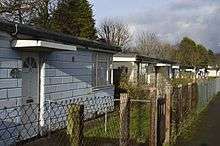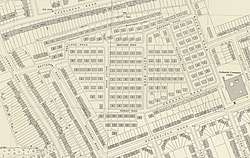Excalibur Estate
The Excalibur Estate is a post-war 1940s housing estate of 189 prefabricated houses in Catford, South London. The estate contains the last sizeable collection of post-war prefabricated houses in the United Kingdom. In 2011, Lewisham Council approved a plan to replace the prefabs with 371 houses, and demolition was scheduled to begin in 2013. English Heritage has granted listed building status to six of the "prefab" houses.[1] The proposed demolition has led to campaigns from residents, English Heritage and the Twentieth Century Society to save the properties,[2] and a legal challenge to prevent redevelopment if they are demolished and return it to parkland.[3]
| Excalibur Estate | |
|---|---|
 Prefabricated houses on the estate | |
| General information | |
| Location | Catford, Lewisham |
| Coordinates | 51.435115°N 0.000604°W |
| No. of flats | 189 |
| Construction | |
| Constructed | 1945-46 |
| Listing | |
Listed Building – Grade II | |
| Designated | 16 March 2009 (six houses) |
| Reference no. | 1393212 |
Background

Following the London Blitz of the Second World War, London was facing a severe housing shortage. To quickly alleviate this problem, London, like many other British cities set about building temporary prefabricated houses using labour from German and Italian prisoners of war from the Afrika Korps captured during Rommel's North African Campaign.
Fifteen hundred homes in Lewisham were destroyed in the first year of the war alone. The level of destruction across many British cities brought about the passing of the Housing (Temporary Accommodation) Act 1944, which led to the building of Excalibur and many estates like it.[4]
The Excalibur Estate was constructed as one of these projects on parkland in Catford between 1945 and 46 by German and Italian prisoners of war. The estate consists of single-story prefabricated bungalows designed by the Ministry of Works; each with two bedrooms, a private garden and an indoor lavatory.[5]
Despite only being intended to stand for ten years, many prefabricated estates survived much longer. Many corporations replaced such estates with conventional-build or permanent prefabricated council houses throughout the 1950s, 60s and early 1970s. Unusually Excalibur survived and is still standing as of June 2015.[6][7]
Etymology
The estate is so called because the streets are named after characters from Arthurian legend. The precise reason for these street names is unknown.[8]
The estate

The estate consists of 189 single storey, two-bedroomed prefabricated bungalows constructed by the Uni-seco company. The nearly flat roofs have a 7 degree pitch. There are no amenities situated on the estate except for the church, St. Marks. This building was originally two huts, it was constructed on site in the conventional manner and a sheet-metal barrelled roof, similar to an Anderson shelter.
Catford has a variety of shops and railway stations, the nearest railway station to the estate being Bellingham.
Demolition proposals
As of 2013, the London Borough of Lewisham proposes to demolish all of the properties on the 12 acres (4.9 ha) site. As they are the last large inhabited collection of prefabricated houses of this era, this decision has proved controversial. English Heritage have stepped in and listed six prefabs, exempting them from demolition. Residents were offered a vote between the estate's demolition or transfer of the estate to a private housing association, which would also demolish the properties.[9] Since Lewisham council began relocating residents in preparation for demolition, residents have complained of an increase in crime, flytipping and antisocial behaviour.[10]
Conservation battle
Conservationists have fought to save the estate from demolition, which they claim is a unique surviving example of twentieth-century architecture. Thus far they have succeeded in seeing Grade II listing applied by English Heritage to six buildings on the estate including St. Mark's Church. The conservation of the estate has been spearheaded by the Twentieth Century Society; claiming that the overall layout and planning of the estate is key to its uniqueness and that just keeping six buildings and surrounding them with new houses does not suffice.[11] Despite the Twentieth Century Society campaigning for the entire estate to be made a conservation area and English Heritage recommending 21 buildings be listed, the Department for Culture would only go so far as to list six of the buildings. Under listing guidelines for twentieth-century buildings, only buildings with few moderations should be listed; in the case of Excalibur, most buildings have modified windows and doors.[8] A prominent local resident favouring conservation stated: "The Excalibur Prefab Estate is the largest of its kind now left in Europe. Europe values its war time history, we on the estate think it’s time we did too."[12] Emily Gee of English Heritage said of the estate: "The historical resonance of the estate is considerable. The design of the buildings, with their subtle modern influences, and the community-focused planning of the estate testifies to the thoughtfulness of post-Blitz reconstruction."[13]
Case for demolition
Lewisham Council have rebutted claims that the houses have historical significance and have maintained that it would be "virtually impossible to bring them up to modern standards, a view shared by a number of residents, who are mainly council tenants."[14] The council have repeatedly argued that residents favour redevelopment; citing a recent poll amongst residents in which 56 percent voted in favour of redevelopment. Conservationists have argued this result was inevitable as residents felt there was very little prospect of the council spending any money on their homes, leaving them in outdated accommodation.[15] Of the estate Lewisham Council stated "We have a responsibility under the national Decent Homes programme to bring all its housing up to a recognised standard. It simply is not financially viable to refurbish the estate."[16] Of the listing, Steve Bullock said. "The listing by English Heritage was perverse and it has made me extremely concerned about the way that organisation behaves… These are temporary prefabricated buildings, not architectural gems"[17]
Redevelopment proposals
In April 2011, Lewisham Council approved a plan to replace the prefabs with 371 homes. Actually this has taken place since 2007 pushed through by L&Q, as it was L&Q who proposed 371 homes as a higher density of homes on the Excalibur Estate land claiming the prefabs were out of date. But it transpired only a portion of the new homes would be for social housing. The project is set for completion by 2018.[18][19]
Parkland covenant
._-_geograph.org.uk_-_377776.jpg)
Campaigners argue that the proposal to build new homes on the site may be subject to legal challenge. Prior to the building of the prefabs, the land was parkland. The land was donated by the then Governor-General of Australia, Lord Forster to the then London County Council as parkland. In a 1946 letter, the London County Council promised to return it to parkland once the temporary houses had been cleared.[3] When Lewisham council took over the estate in 1965, this letter was then made void, as Lewisham council never agreed to uphold the content of this letter. Lewisham Council also claimed no agreement to return the land Excalibur Estate stands on back to park land designation at any time then or now. Nor had Excalibur Estate been designated a temporary housing estate. Uni-Seco the prefab manufacturers and builders never claimed their homes had a life span of only 10 years, as it was claimed prefabs in general had some kind of life span attached to their construction, this was deliberate rumour as to smear the prefab home/building. Please refer to the Uni-Seco prefab system.
Parts of the original Forster Memorial Park are still in existence to the west of Excalibur. Other housing however separates Excalibur from the remaining parts of the park, so if returning the estate to parkland were to become a reality, Forster Memorial Park would be divided into two parts by Longhill Road and Battersby Road.[20]
See also
References
- Historic England (16 March 2009). "Excalibur Estate, Nos 1-7 (Odd), No 25 and No 39 (Grade II) (1393212)". National Heritage List for England. Retrieved 28 November 2018.
- Peter Walker (2 January 2011). "Largest postwar prefab estate to be demolished | Society". London: The Guardian. Retrieved 2 June 2013.
- https://www.telegraph.co.uk/property/8701977/Bulldozers-home-in-on-historic-prefab-estate.html paragraph 28
- paragraph 5
- "Sonia Zhuravlyova: The End is Close for Palaces for the People". Huffingtonpost.co.uk. 20 October 2012. Retrieved 2 June 2013.
- "Google Maps". Google Maps. Retrieved 16 March 2017.
- Taken March 2013.
- https://www.theguardian.com/society/2011/jan/02/postwar-prefab-houses-demolition-london paragraph 6
- paragraph 8
- "Catford Excalibur tenants accuse Lewisham Council of 'gestapo' tactics (From News Shopper)". Newsshopper.co.uk. 25 September 2012. Retrieved 2 June 2013.
- paragraph 3
- Boogie, Doctor (9 March 2008). "The Excalibur Estate, London". Nothing To See Here. Retrieved 2 June 2013.
- paragraph 7
- paragraph 5
- paragraph 11
- paragraph 24
- paragraph 26
- "Lewisham Council - Excalibur". Lewisham.gov.uk. Retrieved 2 June 2013.
- "L&Q: Excalibur Estate Regeneration Project". Lqgroup.org.uk. Archived from the original on 25 May 2013. Retrieved 2 June 2013.
- ISBN 0-540-09036-0 page 164 grid B1
External links
| Wikimedia Commons has media related to Excalibur Estate, Catford. |
- Catford from the OpenStreetMap
- Jim Blackender Excalibur Prefab Estate Catford
- Dan Kitwood An audio account of a resident
- Guardian Residents' accounts
- Simon Jenkins, Guardian Excalibur's castles built from postwar dreams must not be demolished
- Flickr Flickr image gallery
- L&Q, Redevelopment proposals
- Riba Journal Excalibur's End
